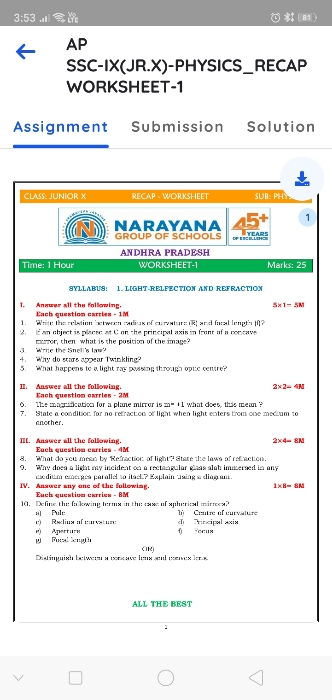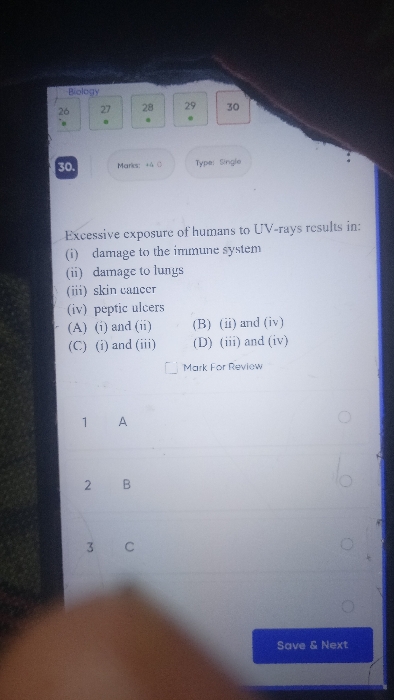CBSE Class 10 Answered
Please find equivalent resistance in each case
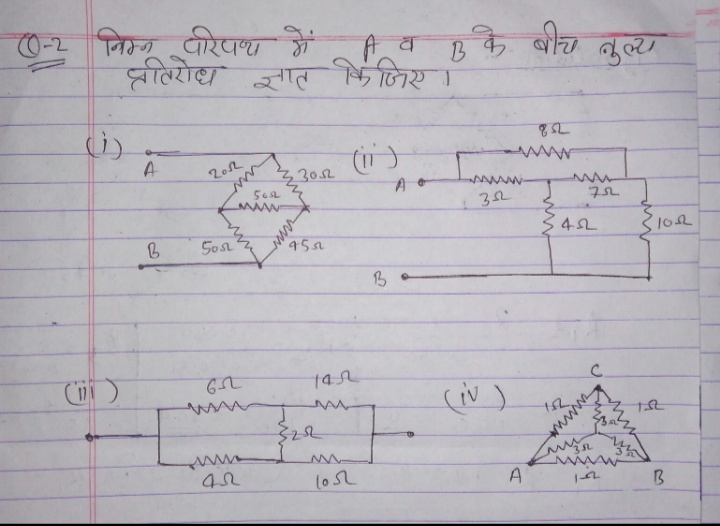
Asked by jackiechrs10 | 07 Feb, 2019, 11:19: PM
Question No. (i) is answered below
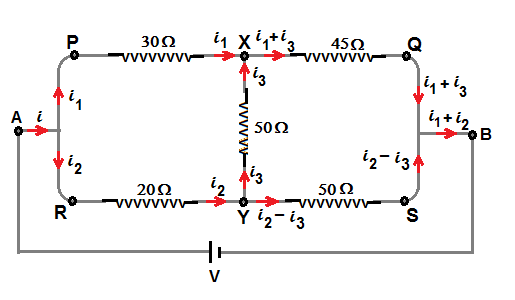
Given network is redrawn as shown above to calculate equivalent resistance.
Let us asssume a potential difference of V volts applied across A and B. Current flowing in the circuit is shown in the figure.
Let us apply Kirchoff's law for the closed path A-P-X-Q-B-A
we have 30×i1+45×(i1+i3) = V or 75×i1+45×i3 = V or 5×i1+3×i3 = (V/15) .......................(1)
Let us apply Kirchoff's law for the closed path A-R-Y-S-B-A
we have 20×i2 + 50×(i2 - i3) = V or 7×i2 - 5×i3 = (V/10) ..........................(2)
Let us apply Kirchoff's law for the closed path P-X-Y-R-P
we have 30×i1 - 50×i3 - 20×i2 = 0 or i2 = (3/2) i1 - (5/2)i3 ............................(3)
By substituting for i2 using eqn.(3) in eqn.(2) and after simplification, we get 21×i1 - 45×i3 = (V/5)..................(4)
By solving eqns. (1) and (4), we get, i1 = ( V/80 ) and i3 = (V/720)
we get i2 from eqn.(3) using the values of i1 and i3 . Hence i2 = (11/720)V
total current drawn due to the potential difference is i = i1 + i2 = (1/80)V + (11/720)V = V/36
hence equivalent resistance = V / ( i1 + i2 ) = 36Ω
----------------------------------------------------------------------------------------------------
Question no. (ii) is answered below

In the given network as shown in figure, across C and D , a 7Ω resistance is connected parallel to a
series combination of 10Ω and 4Ω resistances. Equivalent resistance of resistances connected across C and D
can be calculated and this equivalent resistance is (14/3)Ω.
The modified network after replacing the given resistances across C and D with equivalenet resistance
is shown right side of figure. Equivalent resistance of the modified network can be calculated,
since 8Ω is parallel with the seires combination of 3Ω and (14/3)Ω. Hence equivalent resistance across A and B is 3.9Ω
-----------------------------------------------------------------------------------------------
Question no.(iii) is similar to Question no. (i).
-------------------------------------------------------------------------------------------------
Question no.(iv) is answered below
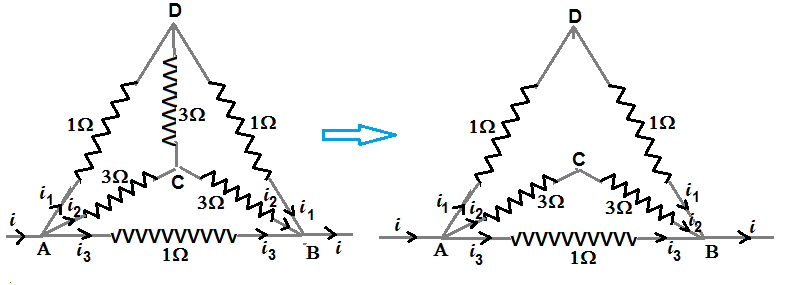
If a current of i enters at inlet point A, it is divided into three parts i1 , i2 and i3 and passing through the resistances as shown in figure.
There is a symmetry of resistance connections at inlet point A and at outlet point B.
If a given current i is divided at inlet A into three parts i1 , i2 and i3 , then at oulet point B also same currents i1 , i2 and i3 are combined to give
total current i . Hence there is no current flow through the resistance connected at C and D and it can be removed
for calculating equivalent resistance as shown in the right side of figure.
Equivalent resistance is parallel combination of 2Ω, 6Ω and 1Ω resistances.
Equivalent resistance = 

Answered by Thiyagarajan K | 10 Feb, 2019, 11:33: PM
CBSE 10 - Science
Asked by sony.lucky455 | 02 Apr, 2024, 03:23: PM
CBSE 10 - Science
Asked by sagarmishra | 18 Mar, 2024, 04:10: PM
CBSE 10 - Science
Asked by srinivasansriharinia9 | 01 Mar, 2024, 08:17: PM
CBSE 10 - Science
Asked by muskanprayagraj78 | 26 Feb, 2024, 05:44: PM
CBSE 10 - Science
Asked by kmannatpreet4 | 21 Feb, 2024, 07:34: PM
CBSE 10 - Science
Asked by umaambiger87 | 08 Feb, 2024, 03:28: PM
CBSE 10 - Science
Asked by pvasanth3573 | 07 Feb, 2024, 10:13: PM
CBSE 10 - Science
Asked by samirankarmakar2702 | 07 Feb, 2024, 09:59: PM

